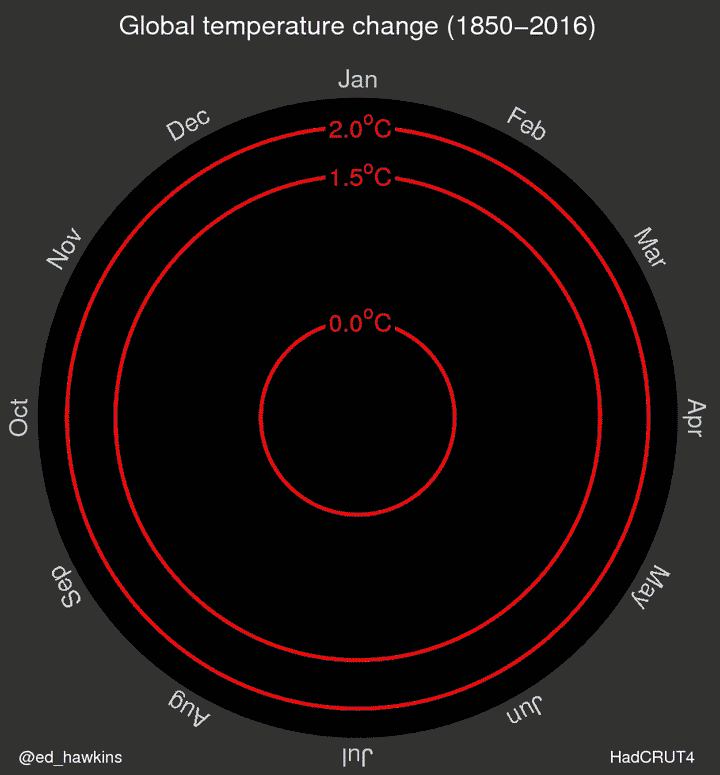This briefing addresses some frequently asked questions about limiting warming to 1.5°C, and explains some of the key issues covered by the IPCC’s 1.5ºC report. (Click here for a printable pdf copy)
In December 2015, the world’s nations, including Australia, adopted the Paris Agreement on climate change. A central element of the Agreement is its long-term goal to hold global warming to well below 2°C above pre-industrial levels and pursue efforts to limit this to 1.5°C. At the same time countries asked the Intergovernmental Panel on Climate Change (IPCC) – the world’s most authoritative climate science body – to advise on how the world can limit global warming to 1.5°C and to examine climate impacts at this level of warming.
Countries also agreed to revisit their current 2030 emissions reductions targets by 2020. This is critical, as the existing targets and policies are not adequate to meet the objectives of the Agreement.2 The IPCC 1.5°C report will inform the process of revising 2030 targets.

Quick answers to the TOP 4 QUESTIONS
1. WHY DOES 1.5°C MATTER? Climate change is already having significant impacts. Limiting warming to 1.5°C would significantly reduce both the frequency and severity of climate change impacts compared to a 2°C, or higher, temperature rise. Click here to read the full answer below.
2. IS IT EVEN POSSIBLE TO LIMIT WARMING TO 1.5°C? The latest research on limiting climate change tells us that warming can be held to 1.5°C, or close to it. However, it requires significant global action to be taken very quickly. Click here to read the full answer below.
3. WHAT ARE THE ECONOMIC COSTS AND BENEFITS OF PURSUING A 1.5°C TARGET? Reducing emissions in line with 1.5°C is 30 times cheaper than the economic damage that would result from allowing warming above this level to 2°C. Many technologies needed to achieve the emissions reductions for 1.5°C are getting cheaper. Click here to read the full answer below.
4. CAN WE USE NEGATIVE EMISSIONS OR CARBON DRAW-DOWN TO GET US OUT OF TROUBLE? Action to reduce emissions has been slow, so we will need “negative emissions” to remain within the 1.5°C limit, or well below 2°C. However, the most urgent focus must be on action to rapidly decarbonise the economy. The faster we can get to zero carbon emissions the more we can limit the amount of negative emissions needed to achieve the objectives of the Paris Agreement. Click here to read the full answer below.
1. WHY DOES 1.5°C MATTER?
“Without effective global climate action, Australia will face risks to the health and resilience of our coasts and beaches including iconic natural systems such as the Great Barrier Reef, cities and the built environment, agriculture, forestry and fisheries, water resources and natural ecosystems, and the health and wellbeing of Australians, with consequent economic costs. Climate change will have implications for disaster risk management and could affect the resilience and security of the Asia-Pacific region.” National Interest Analysis, Paris Agreement, Department of Foreign Affairs and Trade, 2016.3
Climate change is already being felt in Australia and around the world. For example, heatwaves and bushfires have become more extreme and more common, which is affecting the health and wellbeing of Australian people. The Great Barrier Reef has been severely damaged by human induced ocean heatwaves and acidification. Increasingly intense drought and heat are affecting farmers and regional communities.
Limiting warming to 1.5°C would significantly reduce both the frequency and severity of climate change impacts compared to a 2.0°C, or higher, temperature rise.
Even though “half a degree” below 2°C may sound small, limiting warming to 1.5°C significantly reduces harm, cost, and risks that Australia experiences from climate change compared to higher temperature rises. For example, work by Australian scientists suggests that under 2°C of warming, Sydney and Melbourne could experience temperatures of 50°C4, but these extremes would be less likely if warming is limited to 1.5°C.
Australian climate scientists have examined how extreme events of recent years will become more likely as the world warms by 1.5°C and even more frequent and intense with 2°C of warming. Table 1 focuses on several recent extreme events: the ‘Angry Summer’ of 2012-13, when bushfires burned across Tasmania and parts of Melbourne rail and road infrastructure began to fail; the first of two back-toback bleaching events in the Great Barrier Reef in early 2016, which lead to a large coral die-off; and the 2006 drought, in which South East Australia experienced its second-driest year on record.

2. IS IT EVEN POSSIBLE TO LIMIT WARMING TO 1.5°C?
The latest research on limiting climate change tells us that warming can be held to 1.5°C, or very close to it.6 However, the world is currently not on track to limit warming in line with the objectives of the Paris Agreement. Policies currently in place are projected to result in about 3-4°C warming above pre-industrial levels.7 Unless significant global action is undertaken soon, the possibility of limiting warming to 1.5°C, or even 2°C, will become increasingly remote.8
Experts have different views on how likely it is that this will be achieved. Many factors are at play, including technology, economics, policy, politics, society and some aspects of the climate system itself.
So far, we have caused about 1°C warming of average global surface temperatures. The world has seen record high temperatures in recent years, and scientists estimate that unless emissions are reduced rapidly soon the world will reach an average temperature of 1.5°C above preindustrial levels by the 2040s.
Can we ‘reverse’ climate change if we do exceed 1.5°C? Scientists are exploring this because of the difficult situation we’re in after decades of delaying more vigorous action. The higher we overshoot 1.5°C, the greater the need to take carbon pollution out of the atmosphere (See point 4 below). Going over the 1.5°C limit, even temporarily, could have serious, irreversible consequences. The lower we keep the temperature rise the better.
We already have the technology to limit climate change to 1.5°C by 2100, although there are challenges in implementing these at a sufficient scale. Implementation at scale is the central challenge as we will need to use all options available and do so very quickly.
Globally, the changes that would need to occur to give us any chance of avoiding 1.5°C include9:
- Renewable energy must continue to grow at its current rate, until it reaches 100 per cent of power generation by 2050
- No new coal power plants built; and reduce emissions from the world’s existing coal plants by 30 per cent by 2025
- The last fossil fuel-based passenger car sold by 2035
- All new buildings are zero emissions by 2020
- Reduce emissions from forestry and other land use to 95 per cent below 2010 levels by 2030 and stop net deforestation by 2025
3. WHAT ARE THE ECONOMIC COSTS AND BENEFITS OF PURSUING A 1.5°C TARGET?
Failing to meet the 1.5°C limit will be more expensive than meeting it. The costs of limiting warming to 1.5°C can’t be considered without examining the benefits of avoiding severe climate change impacts.
It is extremely hard to confidently estimate how much climate change will cost us economically, because a hotter, more extreme and less stable climate will affect so many aspects of our economy. Economists have developed models to estimate the costs, but these are limited in scope, and have been heavily criticised for understating the true risks and costs.10
Recent work by researchers at Stanford University, which uses historical data on temperature and growth rather than a model, concluded that the costs of reducing emissions in line with 1.5°C are 30 times smaller than the economic damage that would come from allowing warming to increase above this level to 2°C.11
Emissions reductions needed for 1.5°C are getting cheaper. Meanwhile, more and more countries are implementing policies to drive the transition to cheap and clean renewable energy.12 Wind and solar power are becoming the cheapest way to produce electricity, new coal plants are being cancelled even without climate legislation, energy use is falling in many countries, and electric vehicles are being adopted more quickly than expected. The renewable energy sector employs, directly and indirectly, approximately 10.3 million people around the world. The pace of change has surprised optimists and pessimists alike.
The cost of utility-scale solar photovoltaics (PV) has fallen by nearly 75 per cent between 2010 and 2017. Over the same period, offshore wind power and concentrating solar thermal power prices fell by 18 per cent and 33 per cent respectively. Bloomberg New Energy Finance conclude that new solar is already at least as cheap as new coal in Australia, Germany, the US, Spain, Italy and India, and costs are forecast to fall by another twothirds by 2040.13 On the back of falling costs and government support, in 2017 alone, around 70 per cent of new power generation installed globally was renewable energy. More solar PV capacity was added in 2017 than that of coal, gas and nuclear combined.
To limit warming to 1.5°C more will need to be done, but on the back of even current trends, renewable energy is the cheapest source of future power. Countries that don’t promote the smooth transformation of the electricity sector to clean energy are locking themselves into higher future power prices.

